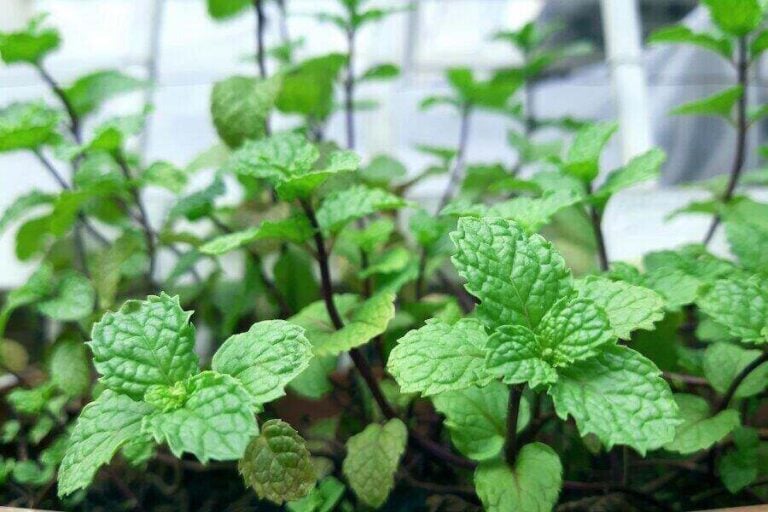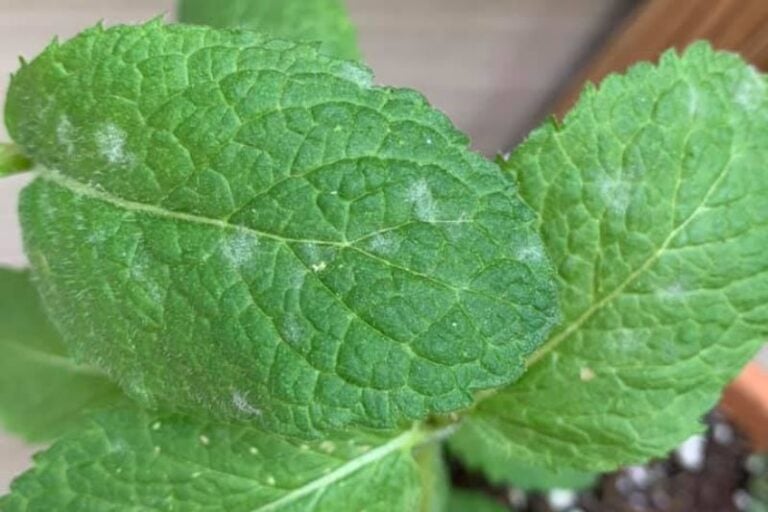When I let my mint plant grow freely, it eagerly stretches out its stems and blossoms beautifully around July or August. If you love seeing these flowers, leaving the plant untouched is best to let it bloom naturally.
Those who enjoy the flowers should plan to prune the plant in the fall after the blossoms have faded.
On the other hand, if your goal in growing mint is to cultivate its leaves, you’d do well to prevent it from flowering if you allow your mint to grow unchecked and bloom, the stems, and leaves become tough.
Unfortunately, this makes them less suitable for garnishing desserts or adding to drinks.
Moreover, the biggest downside is that the fragrance diminishes. You might find that the delightful aroma, one of its key charms, doesn’t stand out as much when the mint flowers.
Therefore, when growing mint, it’s important to decide whether you’re focusing on leaf cultivation or flower display and then decide whether or not to prune accordingly.
If you’re like me and love using fresh mint leaves in your cooking or enjoy their refreshing aroma, you might want to keep your mint plants from blooming.
When mint starts to flower, it pours all its energy into nourishing that bloom, which leaves less for the actual leaf production.
This means your mint leaves could lose their aromatic punch and tender texture. So, if you’re after those high-quality, fragrant mint leaves, preventing your mint plant from flowering is essential.
My advice? Keep a close eye on your plant and trim those flower buds or give them a good pinch as soon as they appear. This way, you’ll ensure your mint plant keeps its focus on producing those lush, flavorful leaves you love.
Contents
How Do You Get Mint to Flower?
If you’re keen on getting your mint to bloom, it’s crucial to meet all its growing requirements. When a plant flowers, it’s a clear sign that it’s happily getting everything it needs for healthy growth.
Not to mention, flowering is a crucial step for plants to produce seeds for the next generation. So, here’s what you need to know to get your mint plant to show off those beautiful blooms.
Planting & Soil Requirements
Mint plants prefer areas with good ventilation and drainage. If the plant doesn’t receive enough sunlight, the color and aroma of the leaves can weaken.
However, mint leaves can get scorched or lose their speckles under direct sunlight, so it’s best to manage your mint in partial shade.
Given their vigorous growth, if you’re managing your mint in pots, you must repot them once a year. Mint is hardy, so you can divide the plant to increase your stock when repotting.
If you prefer not to let the mint get too large, trim it back. Due to their tendency to crossbreed easily, I recommend pot cultivation, even if you’re not in a cold region.
Watering
Water potted mint plants thoroughly once the soil has dried out. If you’ve planted your mint in the ground, it won’t need watering once it’s rooted, although you should be cautious not to let it dry out too much during hot summer periods.
Fertilizing
Mint doesn’t require much fertilizer. If you’re growing it in a pot, once the flowers bloom, about 2 grams (approximately 0.07 ounces) of solid fertilizer per plant will suffice.
Aim to fertilize every three months, but if your mint is planted in the garden, you won’t need to fertilize it much.
Mint Soil Requirements
If you’re growing mint in a pot, using store-bought gardening soil (one with its pH already adjusted) will work perfectly fine.
Mint is adaptable regarding soil and can grow fine without too much fuss over soil preparation. If I had to pick, I’d say it’s not too fond of acidic soil.
So, if you’re planting mint in the ground, you should mix in about 50 grams (approximately 1.76 ounces) of dolomite lime per square meter (approximately 10.8 square feet) of soil.
Creating raised beds for your mint plants isn’t particularly meaningful, as they’ll quickly spread beyond their designated area.
Mint expands through its underground stems, so you’ll need to bury a barrier at least 30 centimeters (about 12 inches) deep in the ground to prevent it from spreading too far and wide.
Alternatively, you can surround your mint plant with peat moss or other strongly acidic soil, slowing its spread.
Final Words
To nurture a durable, long-lasting mint plant, I recommend regular pruning once the plant has achieved a certain level of growth.
Since mint uses a lot of energy to produce flowers, which can weaken its aroma, aim to prune before flowering occurs, cutting back about a third of the stems.
There isn’t a specifically defined period for pruning, but whenever you feel that the mint has grown excessively, go ahead and trim it back.
Overgrown mint can result in poor air circulation and potentially lead to diseases, so keep your mint trim and tidy to prevent any rot at the plant base.







